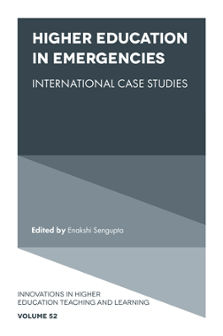
Subject Index
Higher Education in Emergencies: International Case Studies
ISBN: 978-1-83797-345-3, eISBN: 978-1-83797-344-6
ISSN: 2055-3641
Publication date: 6 November 2023
Citation
(2023), "Subject Index", Sengupta, E. (Ed.) Higher Education in Emergencies: International Case Studies (Innovations in Higher Education Teaching and Learning, Vol. 52), Emerald Publishing Limited, Leeds, pp. 139-144. https://doi.org/10.1108/S2055-364120230000052011
Publisher
:Emerald Publishing Limited
Copyright © 2024 Enakshi Sengupta
INDEX
- Prelims
- Part I: Pedagogical Approaches – Higher Education in Emergencies
- Chapter 1: Introduction to Higher Education in Emergencies: International Case Studies
- Chapter 2: Rectifying the Deterioration of EFL Tertiary Students' Speaking Skills in Emergency Times
- Chapter 3: Education in Emergencies and the Changing Landscape of Higher Education in Bangladesh: Cultural Transformation for Policy and Practice
- Chapter 4: Differences in the Digital Divide, Educational Level, and Gender in Turkey During the COVID-19 Pandemic: A Comparison of Turkish Tertiary-Level Sophomore and Junior Students' Views on Online Learning
- Chapter 5: Crossword Puzzle Games, Short Stories, and Mind Maps Assignments as Innovative Online Teaching Methods: Three Promising Applied Experiences During the COVID-19 Pandemic
- Part II: Expectations of Higher Education in Emergencies
- Chapter 6: Students' Perceptions, Attitudes, and Experiences of Higher Education in Emergencies Across Developing Countries Amid COVID-19
- Chapter 7: Lebanese Instructors' Satisfaction with Online Teaching and Learning Amid COVID-19
- Chapter 8: Perceptions of Faculty Officials on Online Learning in Kenyan Institutions of Higher Education During the COVID-19 Pandemic: A Rapid Qualitative Study
- About the Contributors
- Name Index
- Subject Index